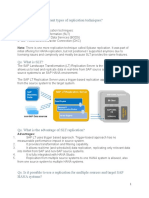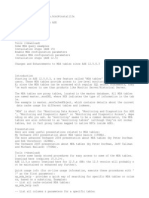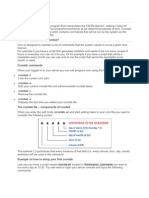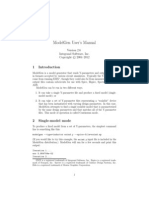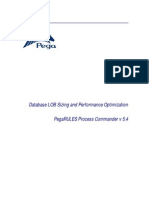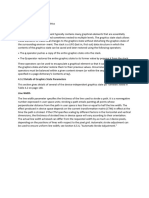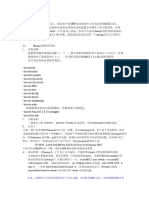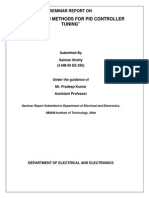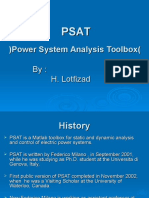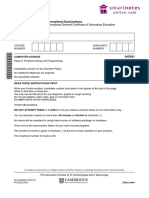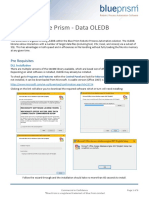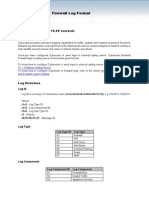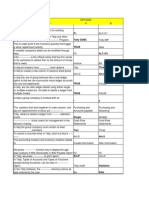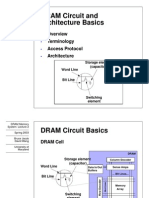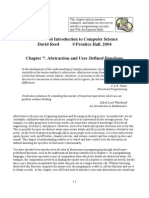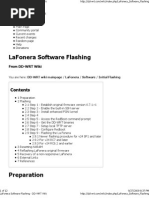Psat-1 3 4
Psat-1 3 4
Uploaded by
Suresh SinghCopyright:
Available Formats
Psat-1 3 4
Psat-1 3 4
Uploaded by
Suresh SinghOriginal Title
Copyright
Available Formats
Share this document
Did you find this document useful?
Is this content inappropriate?
Copyright:
Available Formats
Psat-1 3 4
Psat-1 3 4
Uploaded by
Suresh SinghCopyright:
Available Formats
Chapter 27
Command Line Usage
A set of functions and script les for command line usage of PSAT have been added since PSAT version 1.3.0. These functions get rid of PSAT GUIs, which could be undesired when running PSAT on a remote server/host or when launching PSAT from within user dened routines. The command line usage of PSAT also speeds up operations.
27.1
Basics
Firstly, one needs to set up PSAT environment. Launching the script le initpsat, as follows: >> initpsat will initialize PSAT and display on the Matlab workspace: < P S A T > Copyright (C) 2002-2004 Federico Milano Version 1.3.2 November 2, 2004 PSAT comes with ABSOLUTELY NO WARRANTY; type gnuwarranty for details. This is free software, and you are welcome to redistribute it under certain conditions; type gnulicense for details. Host: Session: Usage: Path: Matlab 7.0.0.19901 (R14) 02-Nov-2004 17:30:23 Command Line /home/fmilano/psatd
Existing workspace variables are not cleared during the initialization, as it happens when launching the PSAT GUI. Clearing the workspace could not be the desired 297
298
27 Command Line Usage
behavior as the command line version of PSAT can be used from within user dened routines. However, observe that all user variables which have same names as a PSAT global variables will be overwritten. Refer to Chapter A for the complete list of PSAT global variables. The scope of PSAT global variables will be the scope of the current workspace from where initpsat is called. If initpsat is called from within a user dened function, the scope will be the function workspace and the PSAT global variables will not be available in the Matlab workspace. To set PSAT global variables in the common Matlab workspace, initpsat must be launched form the Matlab command line of from within a script le.1 Initializing the PSAT variables is required only once for each workspace. A Following steps are setting up the data le and launching a PSAT routine. These operations can be done sequentially or at the same time by means of the function runpsat, as follows: >> runpsat( (datafile runpsat(datafile ,data) runpsat( (routine >> runpsat(routine ) or >> runpsat(datafile ,routine ) runpsat( (datafile where datafile is a string containing the data le name, and routine is a string containing the conventional name of the routine to be executed. The data le can be both a PSAT script le or a PSAT Simulink model. In the latter case the extension .mdl is mandatory. The dierence between the two methods is that when calling only the routine the data le name will not be overwritten. The rst method can be used if the data le under study does not change, while the user wants to perform several dierent analysis, as follows: >> >> >> >> runpsat( (datafile runpsat(datafile ,data) runpsat( (routine1 runpsat(routine1 ) runpsat( (routine2 runpsat(routine2 ) runpsat( (routine3 runpsat(routine3 )
The second method can be used if there are several data les under study: >> runpsat(datafile1 ,routine ) >> runpsat(datafile2 ,routine ) >> runpsat(datafile3 ,routine ) In the previous commands it is assumed that the data le is in the current directory (i.e. the one which is returned by the function pwd). To force PSAT to use a directory other than the current one, commands changes as follows: runpsat( (datafile >> runpsat(datafile ,datapath ,data) runpsat( (routine >> runpsat(routine )
1 The
latter should not have been launched from within a function.
27.1 Basics
299
Table 27.1: String pf cpf snb lib cpfatc sensatc n1cont opf sssa td pmu gams uw
Routine Conventional Names for Command Line Usage. Associated routine power ow analysis continuation power ow analysis direct method for saddle-node bifurcations direct method for limit-induced bifurcations evaluate ATC using CPF analysis evaluate ATC using sensitivity analysis N -1 contingency analysis optimal power ow analysis small signal stability analysis time domain simulation PMU placement OPF analysis through the PSAT-GAMS interface CPF analysis through the PSAT-UWPFLOW interface
or >> runpsat(datafile ,datapath ,routine ) where datapath is the absolute path of the data le. The perturbation le can be set in a similar way as the data le. At this aim, the following commands are equivalent: >> runpsat(pertfile ,pert) >> runpsat(pertfile ,pertpath ,pert) >> runpsat(datafile ,datapath ,pertfile ,pertpath ,routine ) Observe that if setting both the data and the perturbation les, it is necessary to specify as well the absolute paths for both les. The routine names are depicted in Table 27.1. Observe that if runpsat is launched with only one argument, say option, the following notations are equivalent: >> runpsat(option) >> runpsat option Other command line options for runpsat are depicted in Table 27.2. The syntax for the opensys option is the same as the one for data and pert options. If the PSAT variables are not needed anymore, the workspace can be cleared using the command: >> closepsat which will clear only PSAT global structures.
300
27 Command Line Usage
Table 27.2: General Options for Command Line Usage. String Associated routine data set data le pert set perturbation le opensys open solved case savesys save current system log write log le of the current session pfrep write current power ow solution eigrep write eigenvalue report le pmurep write PMU placement report le
input MASTER output SLAVE
Figure 27.1: Master-slave architecture.
27.2
Advanced Usage
The standard usage of PSAT through GUIs monopolizes the Matlab environment and makes dicult to include PSAT routine in other Matlab programs and/or including new features to PSAT. These issues will be briey commented in this section. When using PSAT GUIs, PSAT runs as a master program and the user can initialize and launch each internal routine from the main window. Thus each routine is a slave program (see Figure 27.1). Using this architecture, the only way to include a new routine in PSAT is writing a function which interacts with the PSAT GUIs, shares some of the PSAT global structures and properly exchanges information with PSAT. However, users who want to run PSAT routines within their own algorithms generally need to get rid of GUIs. Thus, the best solution would be to use the user dened program as the master and launching PSAT only when needed, as a slave application. In this way the user only needs to know how to pass and get data to and from PSAT. The latter can be easily solved by using PSAT global structures such as DAE, which mostly contains all variables of the current static solution (power ow, last CPF point, OPF), SSSA which contains the last small signal stability analysis solu-
27.3 Command Line Options
301
Table 27.3: Structures to be modied to change default behavior. Routine Associated structure Power Flow Settings Continuation Power Flow CPF SNB direct method SNB LIB direct method LIB Optimal Power Flow OPF Small Signal Stability Analysis SSSA Time Domain Simulation Settings PMU placement PMU PSAT-GAMS interface GAMS PSAT-UWPFLOW interface UWPFLOW
tion, and Varout which contains the time domain simulation output, the continuation curves or the Pareto set. The structure DAE also contains the current system Jacobian matrices. Refer to Appendix A for details. Passing data and options to PSAT is quite simple if the default behavior is convenient for the current application. Otherwise, one needs to edit the PSAT global structures and set the desired options. Observe that, when using the standard version of PSAT, global structures are edited through the GUIs. Editing global structures from the command line can be a lengthy process, especially if one needs repeating often the same settings. In this case it could be convenient to write a script le where these settings are listed altogether and then launching the script le. Table 27.3 depicts PSAT routines and the associated global structures which dene routine options. A full description of these structures is presented in Appendix A.
27.3
Command Line Options
The default behavior of command line usage of PSAT can be adjusted by means of the structure clpsat, which contains a few options, as follows:2 init command line initialization status. It is 1 if PSAT is running with the standard GUI support, 0 otherwise. The value of this eld should not be changed by the user and is initialized when launching PSAT. mesg status of PSAT messages. If the value is 0, no message will be displayed on the Matlab workspace. Default value is 1. Disabling message display will result in a little bit faster operations. refresh if true (default), forces to repeat power ow before running further analysis independently on the power ow status. This implies that the base case
2 In
the following the word true means the value of the variable is 1 and false means 0.
302
27 Command Line Usage
solution is used as the initial solution for all routines. refreshsim if true, forces to reload Simulink model before running power ow independently on the Simulink model status. Default is false since in the command line usage it is assumed that the user does not want to or cannot use the Simulink graphical interface. readfile if true (default), forces to read data le before running power ow. If the value is false, the data le is not reloaded, and slack generator, PV generator and PQ load data are reinitialized using their elds store. These data need to be reloaded since they might be modied during PSAT computations. showopf if true, forces to display OPF result on the standard output. Default is false. pq2z if true (default), forces to switch PQ loads to constant impedances before running time domain simulations. viewrep if true, forces to display report les when created. Default is false, i.e. the report le is created silently. For the sake of completeness, a summary of the elds of the clpsat structure is also depicted in Appendix A.
27.4
Example
The following script le gives a simple example of command line usage of PSAT. % initialize PSAT initpsat % do not reload data file clpsat.readfile = 0; % set data file runpsat(d 006 mdl,data) % solve base case power flow runpsat(pf) voltages = DAE.V; % increase base loading by 50% for i = 1:10 PQ.store(:,[4,5]) = (1+i/20)*[0.9, 0.6; 1, 0.7; 0.9, 0.6]; PV.store(:,4) = (1+i/20)*[0.9; 0.6]; runpsat(pf) voltages = [voltages, DAE.V];
27.4 Example
303
end % clear PSAT global variables closepsat disp(voltages) Firstly, PSAT is initialized and the readfile option is set to false. Then the le d 006 mdl is loaded (assuming that the le is in the current directory). Following instructions explain how to solve the base case power ow and a series of power ows with increased loads by means of an embedding algorithm. Finally the PSAT variables are cleared and the bus voltages printed on the workspace, as follows: voltages = Columns 1 through 6 1.0500 1.0500 1.0500 0.9859 0.9685 0.9912 1.0500 1.0500 1.0500 0.9820 0.9633 0.9876 1.0500 1.0500 1.0500 0.9781 0.9579 0.9840 1.0500 1.0500 1.0500 0.9741 0.9525 0.9803 1.0500 1.0500 1.0500 0.9700 0.9469 0.9765 1.0500 1.0500 1.0500 0.9660 0.9413 0.9728
Columns 7 through 11 1.0500 1.0500 1.0500 0.9618 0.9356 0.9689 1.0500 1.0500 1.0500 0.9576 0.9298 0.9650 1.0500 1.0500 1.0500 0.9533 0.9239 0.9611 1.0500 1.0500 1.0500 0.9490 0.9179 0.9571 1.0500 1.0500 1.0500 0.9446 0.9118 0.9531
Observe the usage of the store elds of the PV and PQ components. This allows changing the values of the system loading prole without reloading the data le.
You might also like
- SLT Replication Interview QuestionsDocument8 pagesSLT Replication Interview QuestionsParameshwar Reddy KottapalliNo ratings yet
- Velest InstructionsDocument5 pagesVelest Instructionsrizalramadhani789No ratings yet
- GloveDocument10 pagesGlovetareqeee15100% (1)
- Fortran Library of Scientific SubroutinesDocument196 pagesFortran Library of Scientific SubroutinesBasil PolychronopulosNo ratings yet
- Install The MDA TablesDocument8 pagesInstall The MDA TablesKiwiny9999No ratings yet
- CrontabDocument6 pagesCrontabSuresh ReddyNo ratings yet
- ParaphraseDocument51 pagesParaphrasevincent tekeyNo ratings yet
- Sas Chapter 10 Asda Analysis Examples Replication Winter 2010 SasDocument7 pagesSas Chapter 10 Asda Analysis Examples Replication Winter 2010 SasSarbarup BanerjeeNo ratings yet
- Lobster Users Guide 1.2.0Document28 pagesLobster Users Guide 1.2.0Minhaj GhouriNo ratings yet
- Bru Server 1.2.0 Cli GuideDocument69 pagesBru Server 1.2.0 Cli GuideNaveen KumarNo ratings yet
- Model Gen ManDocument9 pagesModel Gen ManArnab Jyoti BaruahNo ratings yet
- Aurora Cidr03Document12 pagesAurora Cidr03CobWangNo ratings yet
- Nrf24l01 Tutorial 3Document4 pagesNrf24l01 Tutorial 3Silvanei Fonseca LeandroNo ratings yet
- Tutorial - Loops and Controls PDFDocument3 pagesTutorial - Loops and Controls PDFTrust NematadziraNo ratings yet
- Samba Configuration in CentosDocument7 pagesSamba Configuration in Centossmith858No ratings yet
- Loop or Cycle Workflow InformaticaDocument8 pagesLoop or Cycle Workflow InformaticazipzapdhoomNo ratings yet
- Build Mamdani Systems (GUI) : On This PageDocument14 pagesBuild Mamdani Systems (GUI) : On This PageJESWNo ratings yet
- CourseREG D49193GC10Document5 pagesCourseREG D49193GC10Imran SaleemNo ratings yet
- Network Analyzer NA C DSDocument2 pagesNetwork Analyzer NA C DSBlue Blooded BedouinNo ratings yet
- Excellentdocument GSM OptimizationDocument58 pagesExcellentdocument GSM OptimizationGaurav SharmaNo ratings yet
- How To Libss7Document12 pagesHow To Libss7Febin WilsonNo ratings yet
- Cadence Redhat 6 InstallationDocument8 pagesCadence Redhat 6 InstallationBahram RN100% (1)
- UMTSDocument5 pagesUMTSbayubisworoNo ratings yet
- DB LOB Sizing v54Document17 pagesDB LOB Sizing v54Jebabalanmari JebabalanNo ratings yet
- Optimizacion (Ingles)Document133 pagesOptimizacion (Ingles)Sergio PeñarandaNo ratings yet
- Workflow DescriptionsDocument31 pagesWorkflow DescriptionsPrabhat Kumar Singh100% (1)
- SCD-2 Implementation To Insert Update and Logically Delete RowsDocument8 pagesSCD-2 Implementation To Insert Update and Logically Delete RowsManshoon HabibNo ratings yet
- Patran 2008 r2 Release GuideDocument80 pagesPatran 2008 r2 Release GuideDonNo ratings yet
- AS400 Dynamic BindDocument5 pagesAS400 Dynamic BindArul Mani SubramaniamNo ratings yet
- Vanetrbc ns2Document5 pagesVanetrbc ns2Shariq Mahmood KhanNo ratings yet
- Using SQLIO To Stress Test An I/O SubsystemDocument6 pagesUsing SQLIO To Stress Test An I/O Subsystemabctester2552No ratings yet
- B202 HashingDocument32 pagesB202 HashingHemant KumarNo ratings yet
- Lab 1.2.5 Verifying RIP v2 Configuration: ObjectiveDocument7 pagesLab 1.2.5 Verifying RIP v2 Configuration: ObjectiveHà TrầnNo ratings yet
- Stqa VivaDocument10 pagesStqa Vivaharshit gargNo ratings yet
- AlertsDocument26 pagesAlertsshailajaNo ratings yet
- Dataentry 171 Compress47Document1 pageDataentry 171 Compress47thakurrahul9821No ratings yet
- Caffa3d MBDocument16 pagesCaffa3d MBJeremy Dudley100% (1)
- MSTest Vs NUnitDocument4 pagesMSTest Vs NUnitAnonymous fxdwmaUNo ratings yet
- RYU Controller TutorialDocument3 pagesRYU Controller TutorialmamadoudianyahooNo ratings yet
- bos.adt.lib bos.adt.libm bos.adt.syscalls bos.rte.SRC bos.rte.libc bos.rte.libcfg bos.rte.libcur bos.rte.libpthreads bos.rte.odm 如果您要安装并行的资源组,还要安装下面的包: bos.rte.lvm.rte5.1.0.25 or higher bos.clvm.enhDocument16 pagesbos.adt.lib bos.adt.libm bos.adt.syscalls bos.rte.SRC bos.rte.libc bos.rte.libcfg bos.rte.libcur bos.rte.libpthreads bos.rte.odm 如果您要安装并行的资源组,还要安装下面的包: bos.rte.lvm.rte5.1.0.25 or higher bos.clvm.enhlaitemp laitempNo ratings yet
- STI09 ANSYS 6.0 Function EditorDocument27 pagesSTI09 ANSYS 6.0 Function EditorRavi Kiran MeesalaNo ratings yet
- ESwitching Lab 2.5.2 Answer Intructor's VersionDocument11 pagesESwitching Lab 2.5.2 Answer Intructor's VersionChris PecasalesNo ratings yet
- Test Program Naming StandardDocument3 pagesTest Program Naming StandardMonal BhoyarNo ratings yet
- Dataentry 170 Compress71Document1 pageDataentry 170 Compress71thakurrahul9821No ratings yet
- C Optimization TechniquesDocument79 pagesC Optimization TechniquesDeepak KaushalNo ratings yet
- Department of Computer Science and Engineering 18Cs43: Operating Systems Lecture Notes (QUESTION & ANSWER)Document8 pagesDepartment of Computer Science and Engineering 18Cs43: Operating Systems Lecture Notes (QUESTION & ANSWER)Manas Hassija100% (1)
- Siphons and Traps Structural Analysis Techniques ConferenceDocument8 pagesSiphons and Traps Structural Analysis Techniques ConferenceMowafak HassanNo ratings yet
- 15.6.1 Packet Tracer Configure Ipv4 and Ipv6 Static and Default RoutesDocument7 pages15.6.1 Packet Tracer Configure Ipv4 and Ipv6 Static and Default Routesstudy timeNo ratings yet
- Report PIDDocument11 pagesReport PIDSaiman ShettyNo ratings yet
- Introduction To Subscriber and Equipment TraceDocument2 pagesIntroduction To Subscriber and Equipment TraceYuma M DasukiNo ratings yet
- Cloud Partitioning of Load Balancing Using Round Robin ModelDocument6 pagesCloud Partitioning of Load Balancing Using Round Robin ModelIJCERT PUBLICATIONSNo ratings yet
- Abap Open SQLDocument31 pagesAbap Open SQLJuan Pablo Vargas RodriguezNo ratings yet
- 4.2 5-Stage Pipeline ARM Organization: Memory Bottle NeckDocument6 pages4.2 5-Stage Pipeline ARM Organization: Memory Bottle NeckchaitudscNo ratings yet
- SNMP V2 and V3Document42 pagesSNMP V2 and V3bharathkumar363No ratings yet
- Power System Analysis ToolboxDocument29 pagesPower System Analysis ToolboxRamaprasad PandaNo ratings yet
- Power System Analysis ToolboxDocument29 pagesPower System Analysis ToolboxCésar Enrique Arroyo Marin100% (1)
- ) Power System Analysis Toolbox (Document29 pages) Power System Analysis Toolbox (Mustadir Darusman B100% (1)
- First Explanation of The ToolDocument2 pagesFirst Explanation of The ToolAndrei StativaNo ratings yet
- SAP interface programming with RFC and VBA: Edit SAP data with MS AccessFrom EverandSAP interface programming with RFC and VBA: Edit SAP data with MS AccessNo ratings yet
- Crime AnalysisDocument13 pagesCrime AnalysisaashritNo ratings yet
- AWS FAQsDocument39 pagesAWS FAQsDivyaNo ratings yet
- 0478 s16 QP 21Document12 pages0478 s16 QP 21Tejas KothariNo ratings yet
- Em X Notification Util BaseDocument65 pagesEm X Notification Util BaseSudhakar SudhaNo ratings yet
- Comandos RacfDocument716 pagesComandos RacfPablo SeguridadNo ratings yet
- 25LQ080B 016B 032BDocument74 pages25LQ080B 016B 032BAlfredo Valencia RodriguezNo ratings yet
- Blue Prism - Guide To OLEDB v2 PDFDocument6 pagesBlue Prism - Guide To OLEDB v2 PDFbnanduriNo ratings yet
- 3 Guide For Describing Assembly Sequences in SAM: 3.1 Unpadded Versus Padded RepresentationDocument1 page3 Guide For Describing Assembly Sequences in SAM: 3.1 Unpadded Versus Padded RepresentationantidemosNo ratings yet
- Chapter - 1 Introduction To ComputerDocument34 pagesChapter - 1 Introduction To ComputerAlex JebaNo ratings yet
- SQL Server Alwayson Basics: WindowsDocument6 pagesSQL Server Alwayson Basics: WindowspraveenmpkNo ratings yet
- Watchguard XTM 33 VPN Router & GreenBow IPsec VPN Software ConfigurationDocument17 pagesWatchguard XTM 33 VPN Router & GreenBow IPsec VPN Software ConfigurationgreenbowNo ratings yet
- Tmw21544 Big Data Analytics RefDocument35 pagesTmw21544 Big Data Analytics Refmahesh0291No ratings yet
- Firewall Log FormatDocument7 pagesFirewall Log FormatLalithaJyothiNo ratings yet
- AKSes User Guide enDocument18 pagesAKSes User Guide envincentiusarnoldNo ratings yet
- Welcome To ROS TopicsDocument2 pagesWelcome To ROS TopicsVan Tung HaNo ratings yet
- SG 246654Document288 pagesSG 246654wetwindNo ratings yet
- Main Report Online Tour TravelsDocument49 pagesMain Report Online Tour Travelsjfdj_898jgkgfNo ratings yet
- ISO 270012005 AwarenessDocument37 pagesISO 270012005 AwarenessTara NondoNo ratings yet
- Sap Suse LinuxDocument136 pagesSap Suse LinuxDheeraj ReddyNo ratings yet
- Itt Questions 1Document156 pagesItt Questions 1Deepak TamboliNo ratings yet
- 86串口屏数据手册V2.1.Zh CN.enDocument93 pages86串口屏数据手册V2.1.Zh CN.endlink377No ratings yet
- Semantic Network and Knowledge GraphDocument35 pagesSemantic Network and Knowledge GraphRichard0% (1)
- 1 Introduction To Visual BasicDocument26 pages1 Introduction To Visual BasicRawol FelipNo ratings yet
- Structure of Design Domain Knowledge BaseDocument4 pagesStructure of Design Domain Knowledge BaseJayesh ChopadeNo ratings yet
- DRAM Lecture2Document32 pagesDRAM Lecture2santanu_sinha87No ratings yet
- CH 7Document26 pagesCH 7Memo YassinNo ratings yet
- Oracle O2C Cycle TablesDocument3 pagesOracle O2C Cycle Tablesnmadhureddy1985No ratings yet
- LaFonera Software Flashing ...Document12 pagesLaFonera Software Flashing ...guptabsNo ratings yet
- Modeling Rbac With Sabsa, Togaf and Archimate: Creating A Foundation For Understanding and ActionDocument27 pagesModeling Rbac With Sabsa, Togaf and Archimate: Creating A Foundation For Understanding and ActionIver BandNo ratings yet
- Cambridge International Examinations: Computer Science 0478/22 May/June 2017Document6 pagesCambridge International Examinations: Computer Science 0478/22 May/June 2017TrynosNo ratings yet
